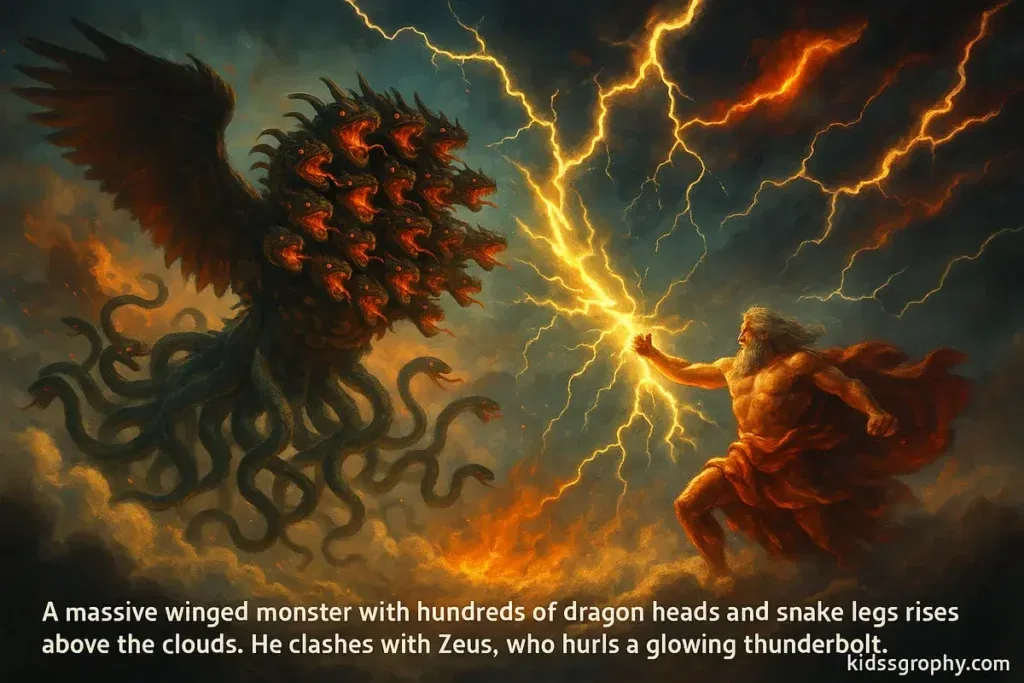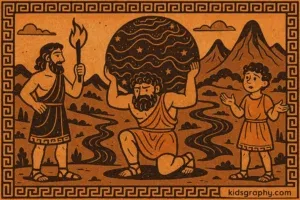In Greek mythology, there are many fearsome creatures—Hydra, Cerberus, the Chimera. But behind them all is a being more terrifying than any other. His name is Typhon, and he is known as the Father of All Monsters.
Typhon wasn’t just a beast. He was a giant, a storm-bringer, and a threat to the gods themselves. Even mighty Zeus, king of the gods, feared him.
Let’s explore the story of Typhon in Greek mythology—his origins, his epic battle with Zeus, his family with Echidna, and how his myth still lives on in books like Percy Jackson.
Who Is Typhon in Greek Mythology?
Typhon (also spelled Typhoeus or Typhaon) is a massive, monstrous figure in ancient Greek myth. He is often described as a giant taller than mountains, with a hundred dragon heads rising from his shoulders and fire blazing from his eyes.
His lower half was made of huge serpent coils, and his voice was said to be a mix of animal roars, human shouts, and thunder. Wings stretched from his back, and storms followed wherever he went.
He wasn’t just scary—he was the final, desperate weapon of Gaia, the Earth goddess. She sent Typhon to punish the gods for defeating her children, the Titans.
Typhon vs. Zeus: The Final Battle
When Typhon rose from the earth, the gods were terrified. According to the myth, many of them fled in fear, disguising themselves as animals to hide. But Zeus, the ruler of Olympus, chose to fight.
This led to one of the most powerful battles in Greek mythology—Typhon vs. Zeus.
They clashed in the skies. Typhon threw mountains and breathed fire. Zeus struck with thunderbolts. The battle shook the heavens and Earth. At one point, Typhon managed to cut Zeus’s muscles from his body, hiding them in a cave.
But Zeus, with the help of Hermes and Pan, recovered. He rose again, stronger than before, and chased Typhon across the land.
Eventually, Zeus defeated him by throwing a final bolt of lightning and crushing Typhon under Mount Etna, the volcano in Sicily. Many believe the eruptions of Etna are Typhon’s fury burning from below.
Typhon and Echidna: Parents of Monsters
Typhon’s story doesn’t end with defeat. Before the great battle, he had a mate—Echidna, a half-woman, half-snake monster. Together, they became the parents of the scariest creatures in all of Greek mythology.
Here are some of their children:
- Cerberus – the three-headed guard dog of the Underworld
- Hydra – a serpent with many heads; cut one, two more grow
- Chimera – part lion, goat, and snake
- Orthrus – a two-headed hound
- Sphinx – the riddle-speaking lion woman
- Nemean Lion – a lion with unbreakable skin
This terrifying couple gave birth to the nightmares that heroes like Heracles and Perseus had to fight. That’s why Typhon is called “Father of Monsters”, and Echidna, “Mother of Monsters.”
Typhon in Greek Culture and Art
Ancient Greeks painted Typhon on vases, describing him in poems and songs. They saw him as the ultimate symbol of chaos and destruction. He wasn’t evil in the human sense—he was raw power, nature out of control.
In some stories, he lived in Cilicia, in a dark cave under a stormy sky. Others believed he was buried beneath Mount Etna, and every earthquake or volcanic eruption was Typhon trying to escape.
Typhon in Percy Jackson and Modern Stories
In modern retellings like the Percy Jackson book series by Rick Riordan, Typhon appears as a nearly unstoppable force.
In The Last Olympian, Typhon escapes from under the mountain and moves across America, destroying everything in his path. The gods are forced to battle him while the heroes defend Olympus. Just like in the ancient myth, Zeus finally brings him down with lightning.
These stories bring Typhon back to life for new generations, showing that even thousands of years later, his legend still stirs fear and excitement.
Why Typhon Still Matters
Typhon isn’t just a monster. He’s the symbol of chaos challenging order. When he rises, he brings fear to even the most powerful. But he also reminds us that power alone isn’t enough—courage and wisdom are what truly win.
Zeus didn’t defeat Typhon easily. He had to fall, recover, and rise again. That part of the myth speaks to us even today—even the strongest struggle. What matters is rising after the fall.
And as long as mountains rumble, storms rage, and stories are told, Typhon will never be forgotten.
More Stories: Greek Mythology
FAQ: Typhon in Greek Mythology
Typhon is a giant monster in Greek mythology known as the Father of All Monsters. He had snake legs, dragon heads, and could breathe fire.
Typhon battled Zeus in a massive war. He almost defeated Zeus, but in the end, Zeus crushed him with a lightning bolt and buried him under Mount Etna.
Typhon’s mate is Echidna, a half-woman, half-snake monster. Together, they gave birth to many famous Greek monsters like Cerberus and Hydra.
Yes, Typhon appears in The Last Olympian. He escapes and attacks the U.S., but the gods eventually stop him, just like in the ancient myth.
Typhon represents chaos, destruction, and the power of nature. He challenged the gods and symbolizes storms, volcanoes, and earthquakes.
Read More: Jacob and Esau











